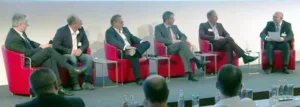The final session was a panel discussion featuring our own Bob Raikes, Ronni Guggenheim of Navori, Brian Dusho of Broadsign, Damon Crowhurst of Scala and Vladimir Kozlov of Digisky and was moderated by Oliver Schwede. Schwede started by asking Raikes about market development.
Although individual regions can be very up and down, broadly over EMEA, the public display market is growing around 20% per year, which makes it attractive to the supply chain, given the low growth in TVs, monitors and other large display applications, Raikes said. On the other hand, Germany is doing poorly, although the Nordics, the UK and Mediterranean are all doing reasonably well.
Crowhurst of Scala said that it had also seen a similar level of growth in software volume, but with declining ASPs over recent years, but in 2013, the ASP was held, so revenues also grew. Dusho said that 20% – 30% growth is also what he sees, although much of this is media outlets that are growing. Crowhurst said that sales in the UK had doubled in 2014 as projects had moved from the 50 screen level to 400 screens. The Nordics are also doing well with lotteries being especially strong. Kozlov said that for Russia, 20% seems flat, as in 2012 there was huge growth. There are lots of mid-size projects with 100 or so screens. Projects in Russia tend not to be over the whole of Europe, so the sizes are smaller.
Dusho said that projects in Europe are much smaller than in the US. In the US, the customers are often switching from custom software. Crowhurst agreed, but he said that he often hears of “big new ideas” that are actually quite old. On the other hand, there’s a lot of work to improve retail and interact with consumers more.
What about consolidation, Schwede asked? Guggenheim said consolidation is difficult, usually with the bigger eating the smaller or the faster eating the slower. However, there is consolidation as the requirements for sophistication increase and scale increases. Dusho said, that attrition is more likely than consolidation – many will be left behind. He also said that just having a CMS is not enough, you need more.
Schwede asked if platforms, with open specs, are more important. Crowhurst said that Scala’s partners have built APIs and custom solutions on a general platform. Dusho said that clients always need something special and big software companies can’t do that, so platforms have to evolve.
Responding to a question, Kozlov said that Russia has roubles and sees now problems with getting Scala or Broadsign software or LG or Samsung displays.
Raikes then said that at IFA and IBC there was a lot of talk about better TV and this could be a challenge as in recent times, digital signs just had to be big, but in the future they will also have to get a lot better. Dusho said that the future is about video and he doesn’t see any real need to compete with the TV experience. Guggenheim said that there is a tremendous growth in “the democratisation” of digital signage. Tools are solid and easy to use and SMBs are starting to use digital signage. Corporates will be able to use small networks of up to 50 displays to build HR and marcom platforms.
Crowhurst said that big players are getting interested in digital signage – he quoted the acquisition by Oracle of Micros-fidelio, a specialist in POS and hospitality, as an example. He also said that there would be more clever things happening in retail.

